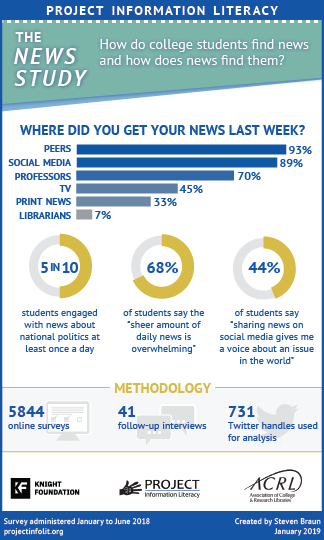Table of contents

Abstract
The News Study research report presents findings about how a sample of US college students gather information and engage with news in the digital age. Results are included from an online survey of 5,844 respondents and telephone interviews with 37 participants from 11 US colleges and universities selected for their regional, demographic, and red/blue state diversity. A computational analysis was conducted using Twitter data associated with the survey respondents and a Twitter panel of 135,891 college-age people. Six recommendations are included for educators, journalists, and librarians working to make students effective news consumers. To explore the implications of this study’s findings, concise commentaries from leading thinkers in education, libraries, media research, and journalism are included.
Preferred citation format: Alison J. Head, John Wihbey, P. Takis Metaxas, Margy MacMillan, and Dan Cohen (October 16, 2018), How Students Engage with News: Five Takeaways for Educators, Journalists, and Librarians, Project Information Literacy Research Institute, https://projectinfolit.org/publications/news-study/
Media coverage
- ”Fake news making college students question all news,” Daniel Funke, Poynter Institute for Media Studies, October 16, 2018.
- “College students as news consumers,” Barbara Fister, Inside Higher Education, October 15, 2018.
- “An information scientist talks media literacy, political memes, and the value of librarians,” Jack Denton, Pacific Standard Magazine, October 25, 2018.

Related PIL resources
“Across the Great Divide: How Today’s College Students Engage with News,” Alison J. Head, Erica DeFrain, Barbara Fister, and Margy MacMillan,” First Monday, August 5, 2019, Volume 24, No. 8 (18 pages).
The News Study has a Creative Commons (CC) license of “CC BY-NCSA 4.0.” This license allows others to share, copy, adapt, and build upon the survey data non-commercially, as long as the source — Project Information Literacy — is credited and users license their new creations under the identical terms.
